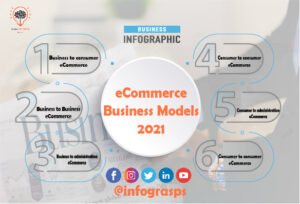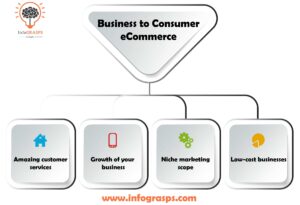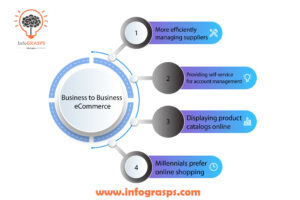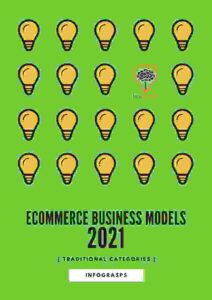eCommerce Business Models 2021
While starting an eCommerce business, the chances are that you’ll have to fall into one of these six general types of eCommerce business models discussed below:
- Business to consumer eCommerce
- Business to Business eCommerce
- Business to administration eCommerce
- Consumer to consumer eCommerce
- Consumer to administration eCommerce
- Consumer to Business eCommerce
Many companies are operating in many of these categories at the same time. Each type has its challenges and benefits. In this article, we will discuss barriers to e-commerce and competitive business models in developing countries. Understanding which category your business idea fits in will help you to avail better opportunities. It will increase your creative thinking about overcoming the threats related to your business idea.
B2C: Business to Consumer eCommerce
The eCommerce b2C business models lie between prevalent forms of eCommerce business models. Its name suggests that it includes the relationship between business and customers. Hence, most of the companies are retailing in nature. Some of them can be included as service providers. Such a type of business is generating more and more revenues year by year. They are selling almost every kind of product by having handicrafts, groceries, software, fashion-related goods, and many more.
The primary purpose of e-commerce B2C business models is to sell to their clients or consumers. The most common business model among all models is the eCommerce B2C business models, so under this umbrella, we can use many different and unique approaches. The things you buy as a consumer using online stores, pages, etc., include household supplies, entertainment, and wardrobe. All these things are done as a part of B2C transactions.
The process of decision making for a B2C purchase is significantly shorter than B2B purchase. Especially when we talk about lower value items, decision making for B2C purchase becomes easier. Such issues were faced, including some barriers to eCommerce and competitive business models in developing countries.
According to 99Firms’ Ecommerce Statistics for 2020, the eCommerce market is not only thriving, but it’s expected that more than 95% of all purchases to be conducted via eCommerce by 2040.
Examples
- Sales rep selling their cars.
- Sales rep selling their gym memberships.
- Stereo systems
- Shoe companies that sell their products directly to consumers through eCommerce.
Benefits of Using B2C eCommerce Businesses
- Amazing Customer Services:
By using eCommerce b2c business models software, customers can communicate with you directly. And it will be easier for you to get appreciation and satisfaction from the excellent customer services provided to them by you.
- Growth of Your Business:
Traditional and old B2C eCommerce does not provide the facilities to expand your business everywhere and reach every place because of a lack of approaches and resources. You can now get the opportunity to increase your businesses quickly by using e-commerce b2c business models software.
But the modern and new ways of business-to-consumer eCommerce provides you with good chances to reach your dreamed level of business in reality.
- Niche Marketing Scope:
The current eCommerce B2C business model strategies allow business holders many opportunities to get into traditional businesses. Business holders can have many opportunities to expand their businesses in the online world.
- Low-Cost Businesses:
Planning for a traditional business, such as a shop, involves many planning and expenses for finding an appropriate place for placing all the stuff. But in e-commerce b2c business models, you can quickly get customers, and you don’t even have to worry about remembering all the things.
- Easier Administration of Business
Business administration becomes easier by eCommerce b2c business models. Because it provides good facilities like delivery process, stores record lists and receiving logs, etc., many other business management tasks are automatically classified, updated, stored, and accessed when clients demand.
B2B: Business to Business eCommerce
The B2B eCommerce model’s primary focus is to provide products and goods from one business to another. There were some barriers to eCommerce and competitive business models in developing countries. Sometimes buyers are the end-users, but buyers resell your products to other consumers or clients. Many of the businesses under this category are service providers. You can still find office supply and furniture companies, software companies, document hosting companies, and many other eCommerce businesses under this category. Generally, longer scale cycles are possessed by the B2B transactions, but it also has higher-order values and even more repetitive purchases.
According to Forrester, U.S. business-to-business (B2B) eCommerce transactions are expected to reach $1.8 trillion by 2023. This would account for 17% of all B2B sales in the country.
Examples:
- Polycom
- V-Belt guys
- YOU
- General Electric
- eJuices
- nicotine river
Benefits:
- More efficiently managing suppliers:
B2B manufacturers usually manage many supplier relationships instantaneously. You should know some of the critical points, such as:
- What are the inventory levels of your supplier?
- What are your current inventory levels?
- You need to order again.
To handle all this, you must use many of the spreadsheets, faxed order forms, phone calls, etc., which is very difficult to manage. You can now easily manage all this by incorporating digitally with all your traders through your eCommerce platform. For example, using workflows and automation, you can easily buy more catalog when you are about to get your stock out. In the long run, it can be beneficial to save your essential time and money.
- Providing self-service for account management
B2B businesses can influence the latest eCommerce technology to put more power into their buyers’ hands. When you provide self-service programs online, you can easily streamline consume the parts of the sales processes. So, your clients don’t need to interact with the sales rep for their every requirement.
- Displaying product catalogs online:
A preeminent challenge faced by merchants in business to business eCommerce is managing an extensive product catalog. But now, there is a technology that facilitates us to handle quickly and display our product information online with dignity and grace.
- Millennials prefer online shopping.
Many of the millennials are converting to online shopping rather than the traditional one. By 2023, most of the b2b buyers will research and buy online and will be Millenials.
B2A: Business to Administration
Another name for B2A is B2G. It refers to a business development that provides its online services to the government. These services are usually offered through a website. An excellent way to understand the business to administration eCommerce is through taxes. Just like TurboTax and H&R block, taxes are provided for governments online through these third parties. Most of the government agencies are using central websites to exchange information and trade with different business organizations.
Examples
One of the most extraordinary examples of B2A is Accela
Accela is a software company which is providing software solutions to the government. And it is also playing a role in public access to administrative services for licensing, permitting, public health, planning, and so on.
Benefits
- You don’t have to hire an employee for updating and maintaining your website. No additional staff will be needed for administrating your business, moreover using AI powered chat boxes will make you able not to check your website 24/7.
C2A: Consumer to Administration
Business to administration includes many different types of services. Some of these services are discussed below:
- Social security
- Legal documents
- Fiscal measures
- Government-related operations
All the electronic transa
Common examples included in their applications are:
- Social security: through distributing the information and making payments etc.
- Health: health services payments, all information about the illness, appointments, etc.
- Education: distance learning, disseminating information, etc.
- Taxes: payments, filing the returns of tax, etc.
Both models that include administration B2A and C2A require the easy usability of facilities and the idea of efficiency provided to consumers. In the start, there were barriers to eCommerce and competitive business models in developing countries.
C2B: Consumer to Business
C2B is another fundamental model in the world of eCommerce business models. Most people don’t think about it immediately, but this is growing very fast among other eCommerce business models. When clients or consumers sell their services or goods to other businesses, this is roughly equal to the sole proprietorship serving a vast company.
Examples
Applications of C2B eCommerce models are:
- Customer reviews
- Focus groups participation
Benefits of the consumer to business
- Convenience:
The Internet provides the facility to customers to buy everything from any place in the world without even moving their location. Even in necessary cases or situations, people restrict themselves to not go shopping just because of bad weather or other such unavoidable circumstances. But eCommerce allows customers to buy from any store or part of the world without making any physical constrictions.
C2C: Consumer to Consumer
A consumer to consumer eCommerce business is an online marketplace which connects clients to exchange their services and goods. These typically make money by listing fees or charging a transaction fee. C2C companies take advantage of self-grown businesses by motivated sellers and buyers.
Examples
- Daraz. pk
- Olx.com
- Ali Express
Benefits of the Consumer eCommerce
- It is not time-consuming.
- Sellers are buyers easily approachable.
- It offers abundant choices for both sellers and buyers.
- A good range of services and products
Ecommerce is enabling people to choose anything of their choice from a variety of services and products from all over the world. In a physical store, a vendor can only manage a minimum amount of goods and products. Maintaining many products in a physical store is a challenging task, so consumer to consumer eCommerce made it easy for everyone to shop and sell online. Virtual store allows a salesperson to store a tremendous amount of products and goods without spending the inventory cost on it. Hence, an eCommerce business provides the consumer with many choices to choose a service or product.
- Money-saving
Most of the time, customers spend more money due to mediators. But because there are no middlemen in online shopping, it saves the customer from bearing the middle person’s extra cost. For attracting more customers and combating competitors, most business organizations are offering services and products at cheaper and lesser rates. Different types of products and goods like music, audio and video clips, software, and e-books can be delivered using internet stores. It can help save money for buyers.
- Time-Saving
Everyone knows that shopping means a lot of time spending, which is not possible always. People are getting busy day by day. So the best benefit of online shopping is that it saves customer’s valuable time. Selecting, buying, and paying for the chosen product don’t take customers more than 15 minutes. Customers are delivered with their products on their doorstep within two or three days or sometimes a week. Ecommerce helps save delivery time for clients.
- Open Always
When you are selling online, your shop will always remain open 24/7/365. Even though you are not getting much customer support, you will still have chances to sell online anytime. Customers can buy at any time from your online store to ensure that your investment will not go waste.
- Data of Customers
While selling online, it gives you access to customer’s data. While shopping online, customers not only provide you with their names, phone numbers, and email addresses, but they also provide the customer’s interest information and customer behavior. Through Google, analytics sellers can access customer’s demographic data that will help the customers market and work more efficiently and accurately.









